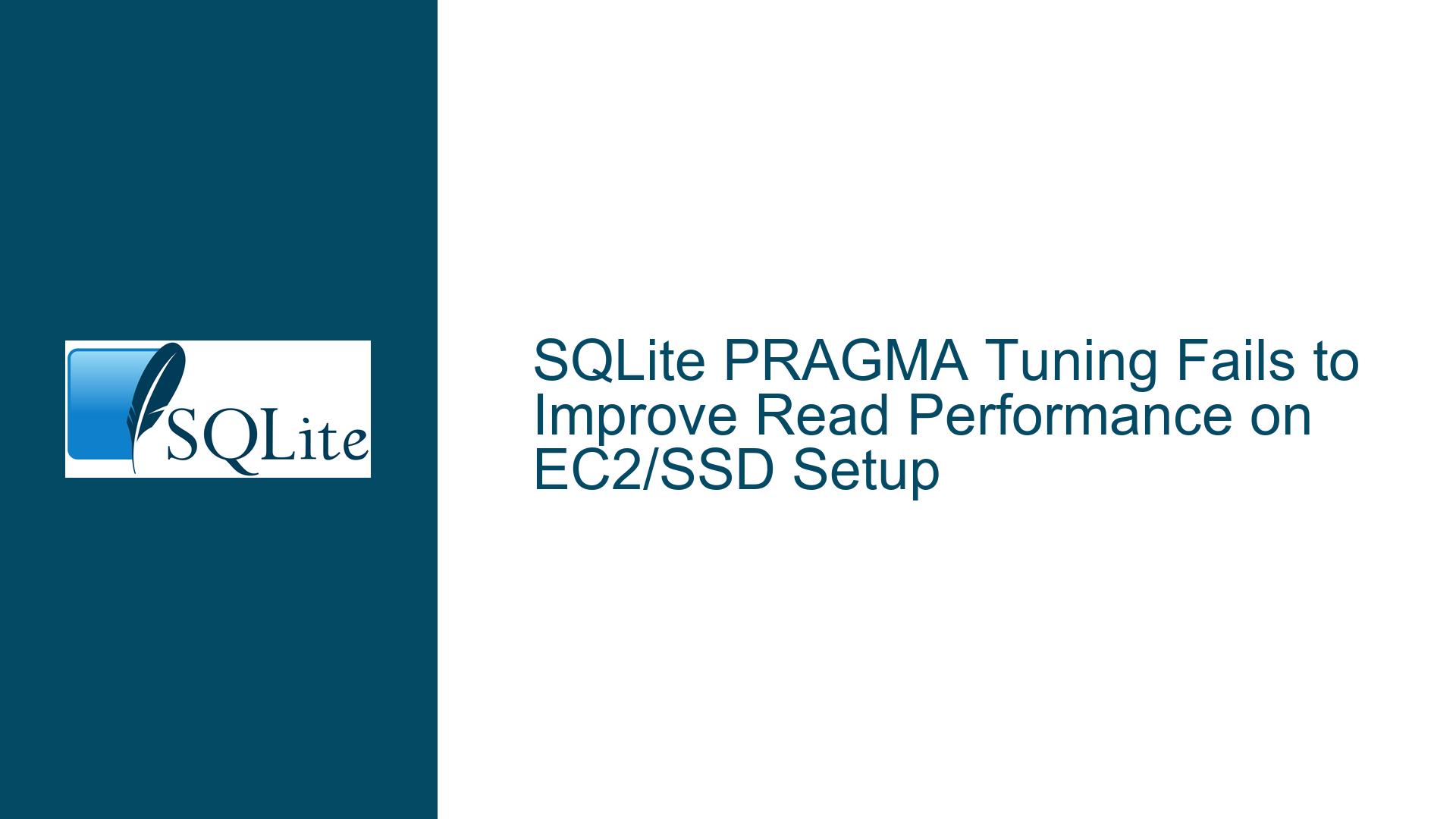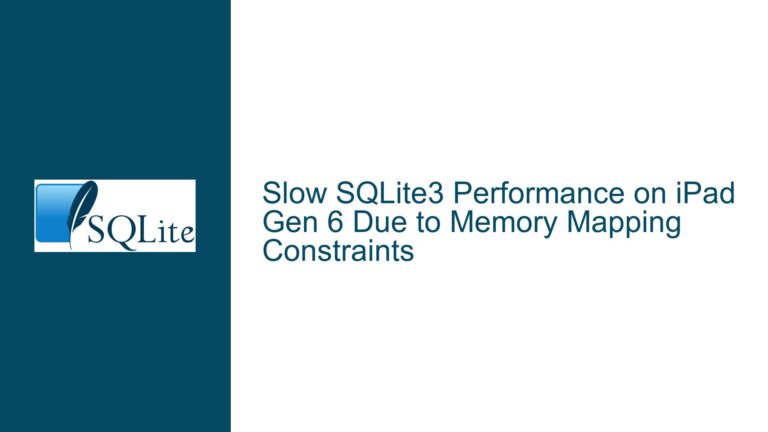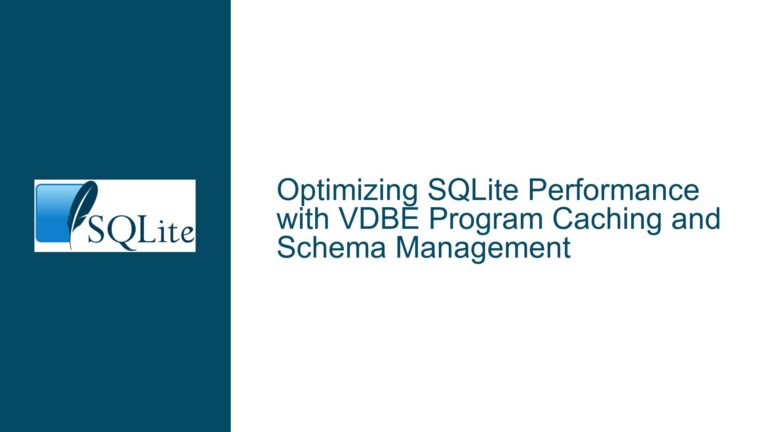SQLite PRAGMA Tuning Fails to Improve Read Performance on EC2/SSD Setup
PRAGMA Configuration Mismatch and Read Performance Stagnation
Issue Overview: High-Expectation PRAGMA Tweaks Underdeliver in Read-Intensive Workload
A developer attempted to optimize SQLite read performance for a 130MB database hosted on an Amazon EC2 t4g.medium instance (2 vCPUs, 4GB RAM, 500GB SSD) by applying aggressive PRAGMA configurations. The goal was to use SQLite as a cache layer above MariaDB, with the expectation that preloading all database pages into memory via cache_size=128000 (~500MB) and enabling write-ahead logging (journal_mode=WAL) would reduce I/O latency. Additional optimizations included disabling synchronous writes (synchronous=OFF), forcing temporary objects to RAM (temp_store=MEMORY), enabling shared cache (shared_cache=ON), and allowing multithreaded sorting (threads=8). Despite these changes, benchmark tests showed no measurable improvement over default PRAGMA settings.
Key observations:
- Cache Preloading Strategy: The developer executed
SELECT *on all tables to force pages into the SQLite page cache but observed no latency reduction. - SSD vs. RAM Assumption: Initial hypothesis suggested SSD read speeds might negate RAM’s benefits, but forum participants rejected this.
- Shared Cache Ambiguity: Conflicting configurations (
shared_cache=ONwithlocking_mode=EXCLUSIVE) were flagged as potential red herrings. - ORM/JDBC Overhead: Preliminary tests ruled out Hibernate ORM as the bottleneck, but JDBC driver inefficiencies remained unexamined.
The core contradiction lies in SQLite’s expected behavior: increasing cache_size beyond the database size should eliminate disk I/O for reads after warm-up. The absence of improvement suggests misconfiguration, measurement errors, or environmental constraints overriding PRAGMA directives.
Root Causes: Misaligned PRAGMA Settings, OS Interference, and Measurement Noise
1. Ineffective PRAGMA Combinations for Read-Intensive Workloads
- Shared Cache Overhead: Enabling
shared_cachein SQLite allows multiple connections to share a single page cache. However, this feature was designed for embedded systems with severe memory constraints, not high-performance servers. Shared cache introduces coarse-grained locks (SHARED, RESERVED) that serialize access, negating concurrency gains fromthreads=8. In read-heavy scenarios, this creates unnecessary contention. - WAL Without Checkpoint Tuning: While
journal_mode=WALimproves write concurrency, it does not directly accelerate reads. The WAL file grows until a checkpoint occurs, and untuned checkpoints (automatic or manual) can stall reads during wal-index synchronization. - Cache Size Misconfiguration: Setting
cache_size=128000(500MB) for a 130MB database assumes SQLite will map the entire database into memory. However, SQLite’s page cache is demand-paged: it only loads pages when accessed. Preloading viaSELECT *forces all pages into cache, but if the OS swaps pages to disk (due to memory pressure), subsequent queries still incur I/O.
2. Operating System Memory Management Contradictions
- Virtual Memory Pagination: Linux’s memory manager treats SQLite’s page cache as part of the process’s private memory. When the system faces memory pressure (e.g., competing processes), the OS may page out portions of the cache to swap space on the SSD. This nullifies the
cache_sizeadvantage, as accessing paged-out memory requires disk I/O at SSD latency (50–100µs) instead of RAM latency (~100ns). - mmap Bypass: SQLite’s
mmapfeature maps database files directly into the process address space, leveraging the OS’s page cache. Whenmmap_sizeis unset, SQLite uses its internal page cache, which is subject to the same OS pagination rules. Not usingmmap(or undersizing it) forces SQLite to manage caching redundantly.
3. JDBC Driver and Transaction Boundary Artifacts
- Auto-Commit Overhead: The xerial JDBC driver defaults to auto-commit mode, wrapping each
SELECTin an implicit transaction. While SQLite handles read transactions efficiently in WAL mode, JDBC’s socket communication and Java object serialization can dominate latency. - Result Set Materialization:
SELECT *queries in JDBC require materializing entire result sets in Java heap memory. For large tables, garbage collection pauses and array resizing overheads skew performance measurements.
4. Misdiagnosed SSD Latency Impact
While SSDs have higher throughput than HDDs, their random read latency (50–100µs) is 1,000× slower than RAM. The developer’s hypothesis that SSD and RAM access times are comparable is incorrect. The true issue is unexpected I/O: even with a large cache_size, if the OS or SQLite cannot retain pages in physical RAM, queries trigger SSD reads.
Resolution Framework: PRAGMA Reconfiguration, OS Tuning, and Profiling
Step 1: Validate PRAGMA Effectiveness and Remove Antipatterns
Disable Shared Cache:
PRAGMA shared_cache = OFF;Shared cache introduces lock contention and is incompatible with high-concurrency read workloads. Test with exclusive per-connection caches.
Configure mmap Instead of cache_size:
PRAGMA mmap_size = 268435456; -- 256MB for 130MB databasemmapbypasses SQLite’s internal page cache, using the OS’s page cache directly. This allows the OS to manage memory more efficiently, retaining hot pages in RAM and reducing copy operations.Reset Thread and Locking Modes:
PRAGMA threads = 0; -- Let SQLite manage threading PRAGMA locking_mode = NORMAL;Overriding
threadscan lead to suboptimal scheduler decisions. Let SQLite’s query planner allocate threads for sorting/indexing.
Step 2: Enforce Physical Memory Retention
Lock Process Memory with mlock:
Usemlockto prevent the OS from paging SQLite’s memory to swap:// C example; adapt to Java via JNI or NIO mlock(database_memory_ptr, database_size);In Java, this requires using
ByteBuffer.allocateDirect()withmlockvia JNI.Monitor Pagination with vmstat:
vmstat -w 1Check
si(swap-in) andso(swap-out) columns. Non-zero values indicate paging.Adjust Linux Swappiness:
sysctl vm.swappiness=0Set
swappiness=0to discourage swapping unless absolutely necessary.
Step 3: Isolate SQLite Performance from Application Overheads
Benchmark with SQLite CLI:
sqlite3 test.db ".timer on" "SELECT * FROM table1;"Compare CLI execution times with Java results to quantify JDBC overhead.
Use Prepared Statements and Batch Fetching:
Connection conn = DriverManager.getConnection("jdbc:sqlite:test.db"); PreparedStatement stmt = conn.prepareStatement("SELECT * FROM table1", ResultSet.TYPE_FORWARD_ONLY, ResultSet.CONCUR_READ_ONLY); stmt.setFetchSize(1000); -- Reduce Java GC pressureForward-only, read-only result sets with fetch batching minimize driver latency.
Profile JVM with Async Profiler:
./profiler.sh -d 60 -f profile.html <pid>Identify hotspots in JDBC driver code (e.g., result set parsing, UTF-8 decoding).
Step 4: Optimize WAL and Checkpoint Behavior
Manual Checkpoint Control:
PRAGMA wal_autocheckpoint = 0; -- Disable automatic checkpointsPeriodically execute
PRAGMA wal_checkpoint(TRUNCATE);during idle periods to prevent WAL growth and wal-index contention.Increase WAL Size Limits:
PRAGMA journal_size_limit = 104857600; -- 100MBAllows WAL to grow larger before forcing a checkpoint, reducing write amplification.
Step 5: Alternative Indexing and Query Strategies
Covering Indexes for Common Queries:
CREATE INDEX idx_covering ON table1 (col1, col2) INCLUDE (col3, col4);Eliminate table heap accesses by including all projected columns in the index.
Leverage In-Memory Databases for Ephemeral Data:
Connection conn = DriverManager.getConnection("jdbc:sqlite:file::memory:?cache=shared");Use shared in-memory databases for truly RAM-resident datasets, bypassing SSD entirely.
Step 6: Concurrency and Connection Pool Tuning
Limit Connection Pool Size:
Configure the connection pool (e.g., HikariCP) to match EC2’s vCPU count:HikariConfig config = new HikariConfig(); config.setMaximumPoolSize(2); -- t4g.medium has 2 vCPUsOver-provisioning connections leads to context switching and lock contention.
Enable URI Filename for Immutable Databases:
jdbc:sqlite:file:///path/to/db?immutable=1For read-only workloads,
immutable=1bypasses locking and journaling entirely.
Step 7: Hardware-Aware Configuration Adjustments
Align SQLite Page Size with SSD Block Size:
PRAGMA page_size = 4096; -- Match SSD sector sizeFormat the database with 4KB pages to align I/O with SSD erase block boundaries.
RAM Disk for Temporary Storage:
mount -t tmpfs -o size=512M tmpfs /mnt/ramdiskMount a RAM disk and set
temp_store_directory=/mnt/ramdiskto store temporary indices and sorts in memory.
Final Validation Metrics
- SQLite Performance Snapshots:
PRAGMA compile_options; -- Verify custom build options PRAGMA cache_stats; -- Check page cache hit rate PRAGMA wal_checkpoint; -- Inspect WAL checkpoint state - Linux Memory Stats:
cat /proc/$(pgrep java)/status | grep VmSwapEnsure no swap usage by the Java process.
By systematically addressing PRAGMA misconfigurations, OS-level memory interference, and JDBC driver inefficiencies, SQLite read performance can be aligned with theoretical expectations. The key is recognizing that SQLite’s caching is a cooperative effort between the library, the OS, and the application’s memory access patterns.






